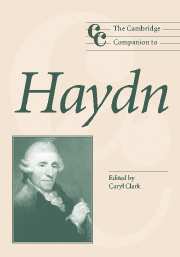Book contents
- Frontmatter
- Part I Haydn in context
- Part II Stylistic and interpretive contexts
- Part III Genres
- 7 Orchestral music: symphonies and concertos
- 8 The quartets
- 9 Intimate expression for a widening public: the keyboard sonatas and trios
- 10 Sacred music
- 11 The sublime and the pastoral in The Creation and The Seasons
- 12 Miscellaneous vocal genres
- 13 Haydn in the theater: the operas
- Part IV Performance and reception
- Index
11 - The sublime and the pastoral in The Creation and The Seasons
from Part III - Genres
Published online by Cambridge University Press: 28 September 2011
- Frontmatter
- Part I Haydn in context
- Part II Stylistic and interpretive contexts
- Part III Genres
- 7 Orchestral music: symphonies and concertos
- 8 The quartets
- 9 Intimate expression for a widening public: the keyboard sonatas and trios
- 10 Sacred music
- 11 The sublime and the pastoral in The Creation and The Seasons
- 12 Miscellaneous vocal genres
- 13 Haydn in the theater: the operas
- Part IV Performance and reception
- Index
Summary
Haydn's oratorios
When Haydn returned to Vienna from London in 1795, he had become a cultural hero. Many of his remaining works originated in collaboration with the cultural-political establishment and were staged as “events” of social and ideological as well as musical import. As a result, his compositional orientation changed fundamentally: he composed little instrumental music except string quartets, devoting himself instead primarily to masses and oratorios. He had composed one earlier oratorio, Il ritorno di Tobia (1774–75); the libretto (by a brother of Boccherini) narrates the story of the blind Tobit from the Apocrypha, whose sight is restored by his son Tobias. Haydn fashioned a magnificent example of late Baroque Austrian-Italian vocal music, comprising chiefly long bravura arias; most of the recitatives are expressive accompagnati. In 1784 he modernized the work, shortening some of the arias, adding two magnificent new choruses, and revising the instrumentation; in this form it has been revived with success.
Haydn's remaining oratorios date from the late Vienna period. He collaborated on all three with Baron Gottfried van Swieten, the imperial librarian and censor and the resolutely high-minded leader of the Gesellschaft der Associirten, an “association” of nobles that subsidized oratorios and other large-scale works. The Seven Last Words of Christ our Saviour on the Cross (winter 1795–96) is not a true oratorio, but a reworking of Joseph Friebert's choral adaptation of Haydn's programmatic orchestral work of 1786.
- Type
- Chapter
- Information
- The Cambridge Companion to Haydn , pp. 150 - 163Publisher: Cambridge University PressPrint publication year: 2005
- 3
- Cited by



